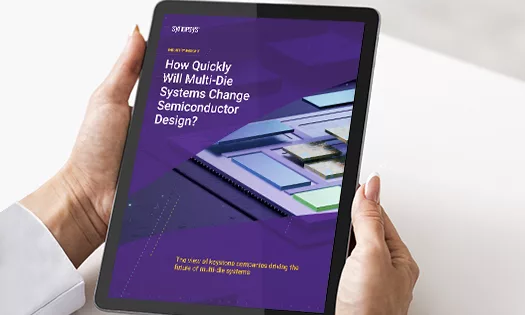Cloud native EDA tools & pre-optimized hardware platforms
MOUNTAIN VIEW, Calif., Sept. 6, 2012 /PRNewswire/ --
Highlights:
- Expands support for modulation formats used in next-generation optical networks
- Accelerates design development with an expanded model library
- Speeds evaluation of optical signal propagation in data communication systems
- Increases user productivity with application examples
Synopsys, Inc. (Nasdaq: SNPS), a world leader in software and IP used in the design, verification and manufacture of electronic components and systems, today announced the availability of the latest release of its RSoft™ Optical Communication Design Suite, which includes OptSim™ and its multimode companion tool ModeSYS™. OptSim version 5.3 delivers innovative modeling capabilities and new application examples that enable engineers to accelerate the design of high-performance optical communication systems.
"Optimized design of existing data links and the advancement of complex future designs can only be achieved with a thorough understanding of the underlying physics and technology involved, as well as the ability to predict performance and recognize design limitations," said Chris Kocot, principal scientist, Finisar Corporation. "At Finisar, simulation software is a crucial facilitator in this process. OptSim is a key component in our suite of software simulation tools used for advanced product development, including 28 Gb/s optical interconnects and next-generation optical links operating at 56 Gb/s per channel, as well as for high-speed link simulations that involve advanced modulation techniques."
Support for Cutting-Edge Modulation Formats
OptSim now includes models for accurately simulating coherent polarization-multiplexed binary phase-shift keying (PM-BPSK) as well as coherent multi-level polarization-multiplexed modulation formats such as PM-16QAM and PM-64QAM. These enhancements can help speed development of advanced applications such as single-carrier 100G Ethernet. The software also supports enhanced orthogonal frequency-division multiplexing (OFDM) models that can handle negative frequencies and calculate error vector magnitudes. This provides engineers with increased flexibility and power when developing OFDM-based systems, such as high-speed long-haul transmission systems with high inter-symbolic interference (ISI).
Application-Specific Models Accelerate Design Development
OptSim now offers the following additions to its model library, which users can incorporate into their designs to jumpstart analysis of a wide range of systems, including photonic integrated circuits, long-reach and ultra-long-reach metro networks, and optical transport networks:
- Y-fed balanced-bridge dual-arm Mach-Zehnder modulator model
- Electrical filter synthesis based on data in Touchstone files
- Model of clipping in the electrical domain
- Phenomenological model for more easily implementing dispersion compensation
"OptSim has been a useful tool, giving us the ability to assess the performance of new systems before components are available for lab testing," said Steven Searcy, optical systems engineer, ADVA Optical Networking. "The ability to obtain preliminary design rules via simulation is critical to staying ahead in the development and introduction of new technologies."
Enhanced Multimode Fiber Modeling Speeds Evaluation of Optical Signal Propagation
ModeSYS includes an updated and enhanced multimode fiber model that provides faster calculation of mode-coupling equations. This can significantly accelerate evaluation of optical signal propagation in data communication systems.
Application Examples Increase User Productivity
New application notes in OptSim demonstrate state-of-the-art examples that can reduce training time for new users and increase efficiency for experienced users. Application [examples] include polarization-multiplexed modulation formats, parametric fiber amplifiers, microwave photonics and multimode systems:
- PM-QPSK modulation using an external local oscillator
- Dual carrier PM-QPSK modulation
- In-band crosstalk in partial DPSK systems
- Phase-sensitive fiber parametric amplifiers
- Microwave photonic links based on balanced detection
- DMD test and measurement per IEC specification 60793-1-49
- EMB test and measurement per IEC specification 60793-1-41
- 25-Gbps directly modulated VCSEL-based multimode links
"OptSim 5.3 adds modeling enhancements that strengthen its standing as an ideal tool for optical communication design and simulation," said George Bayz, vice president and general manager of the Optical Solutions Group at Synopsys. "These new features are augmented by our continued focus on improving user productivity, with an expanded model library and detailed application notes. Our goal is to help engineers develop, test and deliver new systems more efficiently than ever."
Availability & Resources
OptSim version 5.3 is available now and can be obtained by emailing rsoft_sales@synopsys.com. Learn more about Synopsys' RSoft products at https://www.synopsys.com/optical-solutions.html .
About Synopsys' RSoft Products
Synopsys' RSoft products are leading solutions in photonic design software and serve several industries including optical communications, optoelectronics and semiconductor manufacturing. RSoft products provide a full range of design, optimization and planning tools for optical communications, as well as solutions for optoelectronics components and subsystems.
About Synopsys
Synopsys, Inc. (Nasdaq:SNPS) is a world leader in electronic design automation (EDA), supplying the global electronics market with the software, intellectual property (IP) and services used in semiconductor design, verification and manufacturing. Synopsys' comprehensive, integrated portfolio of implementation, verification, IP, manufacturing and field-programmable gate array (FPGA) solutions helps address the key challenges designers and manufacturers face today, such as power and yield management, system-to-silicon verification and time-to-results. These technology-leading solutions help give Synopsys customers a competitive edge in bringing the best products to market quickly while reducing costs and schedule risk. Synopsys is headquartered in Mountain View, California, and has approximately 70 offices located throughout North America, Europe, Japan, Asia and India. Visit Synopsys online at http://www.synopsys.com.
Editorial Contacts:
Tess Cahayag
Synopsys, Inc.
650-584-5446
maritess@synopsys.com
Lisa Gillette-Martin
MCA, Inc.
650-968-8900, ext.115
lgmartin@mcapr.com
SOURCE Synopsys, Inc.





